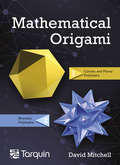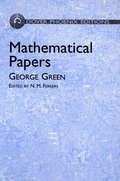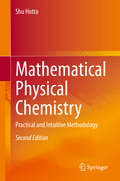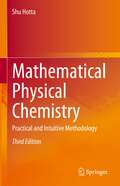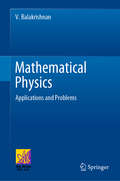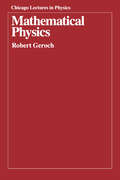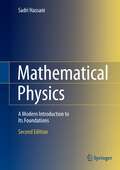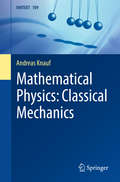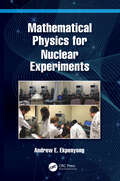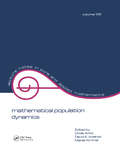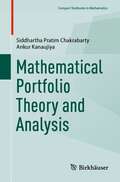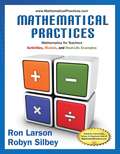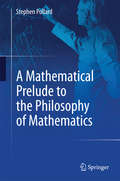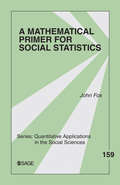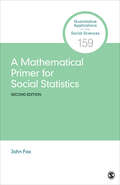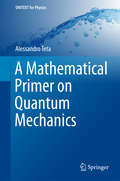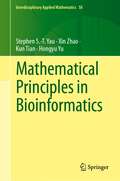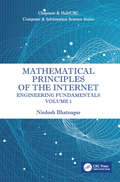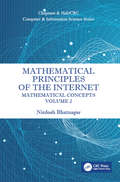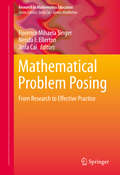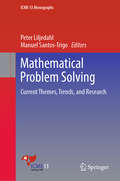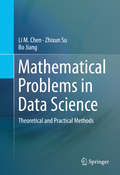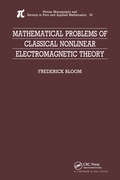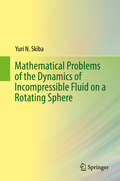- Table View
- List View
Mathematical Origami: Geometrical shapes by paper folding
by David MitchellThis book shows the reader how to make a range of robust polyhedra from ordinary printer paper using a technique known as modular origami. Modular origami designs are made by first folding several, or sometimes many, sheets of paper into simple individual modules and then by putting these modules together, normally without the help of any kind of adhesive, to create a finished polyhedral form. Modular origami design has moved on since the hugely popular first edition which has been expanded and revised to present both a wider range of designs, and to introduce new designs which are more robust and offer more potential for mathematical adventures. Ideal for the classroom and fun for any enthusiast of either origami, or mathematics. David Mitchell gives clear step-by-step instructions.
Mathematical Papers (Dover Books on Mathematics)
by George Green N. M. FerrersAn almost entirely self-taught mathematical genius, George Green (1793 -1841) is best known for Green's theorem, which is used in almost all computer codes that solve partial differential equations. He also published influential essays, or papers, in the fields of hydrodynamics, electricity, and magnetism. This collection comprises his most significant works.The first paper, "An Essay on the Application of Mathematical Analysis to the Theories of Electricity and Magnetism," which is also the longest and perhaps the most Important, appeared In 1828. It introduced the term potential as designating the result obtained by adding together the masses of all the particles of a system, each divided by its distance from a given point. Its three-part treatment first considers the properties of this function and then applies them, in the second and third parts, to the theories of magnetism and electricity.The following paper, "Mathematical Investigations concerning the Laws of the Equilibrium of Fluids analogous to the Electric Fluid," exhibits great analytical power, as does the next, "On the Determination of the Exterior and Interior Attractions of Ellipsoids of Variable Densities." Other highlights include the brief but absorbing paper, "On the Motion of Waves in a variable canal of small depth and width," and two of his most valuable memoirs, "On the Laws of Reflexlon and Refraction of Sound" and "On the Reflexlon and Refraction of Light at the common surface of two non-crystallized Media," which should be studied together.
Mathematical Physical Chemistry: Practical and Intuitive Methodology
by Shu HottaThe second edition of this book has been extensively revised so that readers can gain ready access to advanced topics of mathematical physics including the theory of analytic functions and continuous groups. This easy accessibility helps to create a deeper and clearer insight into mathematical physics, with emphasis on quantum mechanics and electromagnetism along with the theory of linear vector spaces and group theory. The basic nature of the book remains unchanged. The contents are targeted at graduate and undergraduate students majoring in chemistry to supply them with the practical and intuitive methodology of mathematical physics. In parallel, advanced mathematical topics are dealt with in the last chapters of each of the four individual parts so that a close connection among those topics is highlighted. Several important revisions are found in this second edition, however, and they include: (a) a description of set theory and topology that helps to comprehend the essence of the theory of analytic functions and continuous groups; (b) a deep connection between angular momenta and continuous groups; (c) development of the theory of exponential functions of matrices, which is useful to solve differential equations; and (d) updated content on lasers and their applications. This new edition thus provides a balanced selection of new and basic material for chemists and physicists.
Mathematical Physical Chemistry: Practical and Intuitive Methodology
by Shu HottaThe third edition of this book has been updated so that both advanced physics and advanced chemistry can be overviewed from a modern mathematical perspective in a single integrated book. Nowadays key research arears in physics and chemistry such as materials science, molecular science, and device physics are drawing closer and closer together and becoming more and more mathematical. Hence, while retaining the basic feature, the contents are targeted at graduate and undergraduate students majoring in not only chemistry but also physics and engineering. The book covers topics ranging from classical physics (e.g., electromagnetism and analytical mechanics) to quantum science. The latter topic includes an introduction to the quantum theory of fields as well as standard quantum mechanics and quantum chemistry. Tangible examples help readers to understand abstract concepts about the topics covered. Several major revisions have been made and they contain: (a) constitution of the Dirac equation; (b) quantization of the fields; (c) interaction between the quantum fields; (d) basic formalism related to the extended vector spaces and the transformation properties of the Dirac equation; (e) advanced topics of Lie algebra. The new edition thus supplies chemists, physicists, and engineers with fundamental knowledge and calculation methodology of mathematical physics.
Mathematical Physics: Applications and Problems
by V. BalakrishnanThis textbook is aimed at advanced undergraduate and graduate students interested in learning the fundamental mathematical concepts and tools widely used in different areas of physics. The author draws on a vast teaching experience, and presents a comprehensive and self-contained text which explains how mathematics intertwines with and forms an integral part of physics in numerous instances. Rather than emphasizing rigorous proofs of theorems, specific examples and physical applications (such as fluid dynamics, electromagnetism, quantum mechanics, etc.) are invoked to illustrate and elaborate upon the relevant mathematical techniques. The early chapters of the book introduce different types of functions, vectors and tensors, vector calculus, and matrices. In the subsequent chapters, more advanced topics like linear spaces, operator algebras, special functions, probability distributions, stochastic processes, analytic functions, Fourier series and integrals, Laplace transforms, Green's functions and integral equations are discussed. The book also features about 400 exercises and solved problems interspersed throughout the text at appropriate junctures, to facilitate the logical flow and to test the key concepts. Overall this book will be a valuable resource for a wide spectrum of students and instructors of mathematical physics.
Mathematical Physics
by Robert GerochMathematical Physics is an introduction to such basic mathematical structures as groups, vector spaces, topological spaces, measure spaces, and Hilbert space. Geroch uses category theory to emphasize both the interrelationships among different structures and the unity of mathematics. Perhaps the most valuable feature of the book is the illuminating intuitive discussion of the "whys" of proofs and of axioms and definitions. This book, based on Geroch's University of Chicago course, will be especially helpful to those working in theoretical physics, including such areas as relativity, particle physics, and astrophysics.
Mathematical Physics: A Modern Introduction to Its Foundations
by Sadri HassaniThe goal of this book is to expose the reader to the indispensable role that mathematics---often very abstract---plays in modern physics. Starting with the notion of vector spaces, the first half of the book develops topics as diverse as algebras, classical orthogonal polynomials, Fourier analysis, complex analysis, differential and integral equations, operator theory, and multi-dimensional Green's functions. The second half of the book introduces groups, manifolds, Lie groups and their representations, Clifford algebras and their representations, and fiber bundles and their applications to differential geometry and gauge theories. This second edition is a substantial revision of the first one with a complete rewriting of many chapters and the addition of new ones, including chapters on algebras, representation of Clifford algebras and spinors, fiber bundles, and gauge theories. The spirit of the first edition, namely the balance between rigor and physical application, has been maintained, as is the abundance of historical notes and worked out examples that demonstrate the "unreasonable effectiveness of mathematics" in modern physics. Einstein has famously said, "The most incomprehensible thing about nature is that it is comprehensible." What he had in mind was reiterated in another one of his famous quotes concerning the question of how " ... mathematics, being after all a product of human thought, is so admirably appropriate to the objects of reality." It is a question that comes to everyone's mind when encountering the highly abstract mathematics required for a deep understanding of modern physics. It is the experience that Eugene Wigner so profoundly described as "the unreasonable effectiveness of mathematics in the natural sciences." Some praise for the previous edition: PAGEOPH [Pure and Applied Geophysics] Review by Daniel Wojcik, University of Maryland "This volume should be a welcome addition to any collection. The book is well written and explanations are usually clear. Lives of famous mathematicians and physicists are scattered within the book. They are quite extended, often amusing, making nice interludes. Numerous exercises help the student practice the methods introduced. ... I have recently been using this book for an extended time and acquired a liking for it. Among all the available books treating mathematical methods of physics this one certainly stands out and assuredly it would suit the needs of many physics readers." ZENTRALBLATT MATH Review by G.Roepstorff, University of Aachen, Germany "... Unlike most existing texts with the same emphasis and audience, which are merely collections of facts and formulas, the present book is more systematic, self-contained, with a level of presentation that tends to be more formal and abstract. This entails proving a large number of theorems, lemmas, and corollaries, deferring most of the applications that physics students might be interested in to the example sections in small print. Indeed, there are 350 worked-out examples and about 850 problems. ... A very nice feature is the way the author intertwines the formalism with the life stories and anecdotes of some mathematicians and physicists, leading at their times. As is often the case, the historical view point helps to understand and appreciate the ideas presented in the text. ... For the physics student in the middle of his training, it will certainly prove to be extremely useful." THE PHYSICIST Review by Paul Davies, Orion Productions, Adelaide, Australia "I am pleased to have so many topics collected in a single volume. All the tricks are there of course, but supported by sufficient rigour and substantiation to make the dedicated mathematical physicist sigh with delight." EMS [EUROPEAN MATHEMATICAL SOCIETY] NEWSLETTER "This book is a condensed exposition of the mathematics that is met in most parts of physics. The presentation attains a very good balance between the formal introduction of concepts, theorems and proofs on one hand, and the applied approach on the other, with many examples, fully...
Mathematical Physics: Classical Mechanics (UNITEXT #109)
by Andreas Knauf Jochen DenzlerAs a limit theory of quantum mechanics, classical dynamics comprises a large variety of phenomena, from computable (integrable) to chaotic (mixing) behavior. This book presents the KAM (Kolmogorov-Arnold-Moser) theory and asymptotic completeness in classical scattering. Including a wealth of fascinating examples in physics, it offers not only an excellent selection of basic topics, but also an introduction to a number of current areas of research in the field of classical mechanics. Thanks to the didactic structure and concise appendices, the presentation is self-contained and requires only knowledge of the basic courses in mathematics.The book addresses the needs of graduate and senior undergraduate students in mathematics and physics, and of researchers interested in approaching classical mechanics from a modern point of view.
Mathematical Physics for Nuclear Experiments
by Andrew E. EkpenyongMathematical Physics for Nuclear Experiments presents an accessible introduction to the mathematical derivations of key equations used in describing and analysing results of typical nuclear physics experiments. Instead of merely showing results and citing texts, crucial equations in nuclear physics such as the Bohr’s classical formula, Bethe’s quantum mechanical formula for energy loss, Poisson, Gaussian and Maxwellian distributions for radioactive decay, and the Fermi function for beta spectrum analysis, among many more, are presented with the mathematical bases of their derivation and with their physical utility. This approach provides readers with a greater connection between the theoretical and experimental sides of nuclear physics. The book also presents connections between well-established results and ongoing research. It also contains figures and tables showing results from the author’s experiments and those of his students to demonstrate experimental outcomes. This is a valuable guide for advanced undergraduates and early graduates studying nuclear instruments and methods, medical and health physics courses as well as experimental particle physics courses. Key features Contains over 500 equations connecting theory with experiments. Presents over 80 examples showing physical intuition and illustrating concepts. Includes 80 exercises, with solutions, showing applications in nuclear and medical physics.
mathematical population dynamics: Proceedings of the Second International Conference
by Ovide ArinoThis book is an outcome of the Second International Conference on Mathematical Population Dynamics. It is intended for mathematicians, statisticians, biologists, and medical researchers who are interested in recent advances in analyzing changes in populations of genes, cells, and tumors.
Mathematical Portfolio Theory and Analysis (Compact Textbooks in Mathematics)
by Siddhartha Pratim Chakrabarty Ankur KanaujiyaDesigned as a self-contained text, this book covers a wide spectrum of topics on portfolio theory. It covers both the classical-mean-variance portfolio theory as well as non-mean-variance portfolio theory. The book covers topics such as optimal portfolio strategies, bond portfolio optimization and risk management of portfolios. In order to ensure that the book is self-contained and not dependent on any pre-requisites, the book includes three chapters on basics of financial markets, probability theory and asset pricing models, which have resulted in a holistic narrative of the topic. Retaining the spirit of the classical works of stalwarts like Markowitz, Black, Sharpe, etc., this book includes various other aspects of portfolio theory, such as discrete and continuous time optimal portfolios, bond portfolios and risk management. The increase in volume and diversity of banking activities has resulted in a concurrent enhanced importance of portfolio theory, both in terms of management perspective (including risk management) and the resulting mathematical sophistication required. Most books on portfolio theory are written either from the management perspective, or are aimed at advanced graduate students and academicians. This book bridges the gap between these two levels of learning. With many useful solved examples and exercises with solutions as well as a rigorous mathematical approach of portfolio theory, the book is useful to undergraduate students of mathematical finance, business and financial management.
Mathematical Practices, Mathematics For Teachers
by Ron Larson Robyn SilbeyTo become a successful mathematics teacher, you must first become a successful mathematics student. Ron Larson and Robyn Silbey's first edition of MATHEMATICAL PRACTICES, MATHEMATICS FOR TEACHERS: ACTIVITIES, MODELS, AND REAL-LIFE EXAMPLES helps students aspire to be the best educators they can be. Peruse the book and you'll find Classroom Activities integrated into each section; modeling Examples that ask students how to model math concepts in the classroom; real-life Examples that model math concepts students will encounter in their everyday lives; and finally, to frame Ron and Robyn's approach, Common Core State Standards relevant to each lesson to provide future teachers with the knowledge of what their students should know at various grade levels.
A Mathematical Prelude to the Philosophy of Mathematics
by Stephen PollardThis book is based on two premises: one cannot understand philosophy of mathematics without understanding mathematics and one cannot understand mathematics without doing mathematics. It draws readers into philosophy of mathematics by having them do mathematics. It offers 298 exercises, covering philosophically important material, presented in a philosophically informed way. The exercises give readers opportunities to recreate some mathematics that will illuminate important readings in philosophy of mathematics. Topics include primitive recursive arithmetic, Peano arithmetic, Gödel's theorems, interpretability, the hierarchy of sets, Frege arithmetic and intuitionist sentential logic. The book is intended for readers who understand basic properties of the natural and real numbers and have some background in formal logic.
A Mathematical Primer for Social Statistics
by Dr John FoxJohn Fox's A Mathematical Primer for Social Statistics covers many often ignored yet important topics in mathematics and mathematical statistics. This text provides readers with the foundation on which an understanding of applied statistics rests. Intended Audience This book is ideal for advanced undergraduates, graduate students, and researchers in the social sciences who need to understand and use relatively advanced statistical methods but whose mathematical preparation for this work is insufficient. Learn more about "The Little Green Book" QASS Series! Click Here.
A Mathematical Primer for Social Statistics (Quantitative Applications in the Social Sciences)
by John FoxA Mathematical Primer for Social Statistics, Second Edition presents mathematics central to learning and understanding statistical methods beyond the introductory level: the basic "language" of matrices and linear algebra and its visual representation, vector geometry; differential and integral calculus; probability theory; common probability distributions; statistical estimation and inference, including likelihood-based and Bayesian methods. The volume concludes by applying mathematical concepts and operations to a familiar case, linear least-squares regression. The Second Edition pays more attention to visualization, including the elliptical geometry of quadratic forms and its application to statistics. It also covers some new topics, such as an introduction to Markov-Chain Monte Carlo methods, which are important in modern Bayesian statistics. A companion website includes materials that enable readers to use the R statistical computing environment to reproduce and explore computations and visualizations presented in the text. The book is an excellent companion to a "math camp" or a course designed to provide foundational mathematics needed to understand relatively advanced statistical methods.
A Mathematical Primer for Social Statistics (Quantitative Applications in the Social Sciences)
by John FoxA Mathematical Primer for Social Statistics, Second Edition presents mathematics central to learning and understanding statistical methods beyond the introductory level: the basic "language" of matrices and linear algebra and its visual representation, vector geometry; differential and integral calculus; probability theory; common probability distributions; statistical estimation and inference, including likelihood-based and Bayesian methods. The volume concludes by applying mathematical concepts and operations to a familiar case, linear least-squares regression. The Second Edition pays more attention to visualization, including the elliptical geometry of quadratic forms and its application to statistics. It also covers some new topics, such as an introduction to Markov-Chain Monte Carlo methods, which are important in modern Bayesian statistics. A companion website includes materials that enable readers to use the R statistical computing environment to reproduce and explore computations and visualizations presented in the text. The book is an excellent companion to a "math camp" or a course designed to provide foundational mathematics needed to understand relatively advanced statistical methods.
A Mathematical Primer on Quantum Mechanics (UNITEXT for Physics)
by Alessandro TetaThis book offers a rigorous yet elementary approach to quantum mechanics that will meet the needs of Master’s-level Mathematics students and is equally suitable for Physics students who are interested in gaining a deeper understanding of the mathematical structure of the theory. Throughout the coverage, which is limited to single-particle quantum mechanics, the focus is on formulating theory and developing applications in a mathematically precise manner. Following a review of selected key concepts in classical physics and the historical background, the basic elements of the theory of operators in Hilbert spaces are presented and used to formulate the rules of quantum mechanics. The discussion then turns to free particles, harmonic oscillators, delta potential, and hydrogen atoms, providing rigorous proofs of the corresponding dynamical properties. Starting from an analysis of these applications, readers are subsequently introduced to more advanced topics such as the classical limit, scattering theory, and spectral analysis of Schrödinger operators. The main content is complemented by numerous exercises that stimulate interactive learning and help readers check their progress.
Mathematical Principles in Bioinformatics (Interdisciplinary Applied Mathematics #58)
by Stephen S.-T. Yau Xin Zhao Kun Tian Hongyu YuThis textbook introduces bioinformatics to students in mathematics with no biology background assumed and it provides solid mathematical tools for biology students along with an understanding of how to implement them in bioinformatics problems. In addition to the basics, the text offers new approaches to understanding biological sequences. The concise presentation distinguishes itself from others on the subject, discussing and providing principles that relate to current open problems in bioinformatics as well as considering a variety of models. The convex hull principle is highlighted, opening a new interdisciplinary research area at the intersection of biology, mathematics, and computer science. Prerequisites include first courses in linear algebra, probability and statistics, and mathematical analysis. Researchers in mathematics, biology, and math-biology, will also find aspects of this text useful. This textbook is written based on the authors' research works that have been published in various journals along with the lecture notes used when teaching bioinformatics courses at the University of Illinois at Chicago and at Tsinghua University. The content may be divided into two parts. The first part includes three chapters, introducing some basic concepts. Chapter 1 provides biological background in molecular biology for mathematicians. Chapter 2 describes biological databases that are commonly used. Chapter 3 is concerned with alignment methods including global/local alignment, heuristic alignment, and multiple alignment. The second part consisting of five chapters, describes several bioinformatics principles using a rigorous mathematical formulation. Chapter 4 introduces the time-frequency spectral principle and its applications in bioinformatics. In Chapters 5 and 6, two strategies are used, the graphical representation and the natural vector method, to represent biological sequences, and conduct sequence comparison and phylogenetic analysis without alignment. Chapter 7 presents the convex hull principle and shows how it can be used to mathematically determine whether a certain amino acid sequence can be a protein. The last chapter summarizes additional mathematical ideas relating to sequence comparisons, such as new feature vectors and metrics. This part focuses on the governing principle in biology and provides plenty of alignment-free methods, which cannot be found in any other book.
Mathematical Principles of the Internet, Volume 1: Engineering (Chapman & Hall/CRC Computer and Information Science Series)
by Nirdosh BhatnagarThis two-volume set on Mathematical Principles of the Internet provides a comprehensive overview of the mathematical principles of Internet engineering. The books do not aim to provide all of the mathematical foundations upon which the Internet is based. Instead, they cover a partial panorama and the key principles. Volume 1 explores Internet engineering, while the supporting mathematics is covered in Volume 2. The chapters on mathematics complement those on the engineering episodes, and an effort has been made to make this work succinct, yet self-contained. Elements of information theory, algebraic coding theory, cryptography, Internet traffic, dynamics and control of Internet congestion, and queueing theory are discussed. In addition, stochastic networks, graph-theoretic algorithms, application of game theory to the Internet, Internet economics, data mining and knowledge discovery, and quantum computation, communication, and cryptography are also discussed. In order to study the structure and function of the Internet, only a basic knowledge of number theory, abstract algebra, matrices and determinants, graph theory, geometry, analysis, optimization theory, probability theory, and stochastic processes, is required. These mathematical disciplines are defined and developed in the books to the extent that is needed to develop and justify their application to Internet engineering.
Mathematical Principles of the Internet, Volume 2: Mathematics (Chapman & Hall/CRC Computer and Information Science Series)
by Nirdosh BhatnagarThis two-volume set on Mathematical Principles of the Internet provides a comprehensive overview of the mathematical principles of Internet engineering. The books do not aim to provide all of the mathematical foundations upon which the Internet is based. Instead, they cover a partial panorama and the key principles. Volume 1 explores Internet engineering, while the supporting mathematics is covered in Volume 2. The chapters on mathematics complement those on the engineering episodes, and an effort has been made to make this work succinct, yet self-contained. Elements of information theory, algebraic coding theory, cryptography, Internet traffic, dynamics and control of Internet congestion, and queueing theory are discussed. In addition, stochastic networks, graph-theoretic algorithms, application of game theory to the Internet, Internet economics, data mining and knowledge discovery, and quantum computation, communication, and cryptography are also discussed. In order to study the structure and function of the Internet, only a basic knowledge of number theory, abstract algebra, matrices and determinants, graph theory, geometry, analysis, optimization theory, probability theory, and stochastic processes, is required. These mathematical disciplines are defined and developed in the books to the extent that is needed to develop and justify their application to Internet engineering.
Mathematical Problem Posing
by Florence Mihaela Singer Nerida F. Ellerton Jinfa CaiThe mathematics education community continues to contribute research-based ideas for developing and improving problem posing as an inquiry-based instructional strategy for enhancing students' learning. A large number of studies have been conducted which have covered many research topics and methodological aspects of teaching and learning mathematics through problem posing. The Authors' groundwork has shown that many of these studies predict positive outcomes from implementing problem posing on: student knowledge, problem solving and posing skills, creativity and disposition toward mathematics. This book examines, in-depth, the contribution of a problem posing approach to teaching mathematics and discusses the impact of adopting this approach on the development of theoretical frameworks, teaching practices and research on mathematical problem posing over the last 50 years.
Mathematical Problem Solving: Current Themes, Trends And Research (ICME-13 Monographs)
by Peter Liljedahl Manuel Santos-TrigoThis book contributes to the field of mathematical problem solving by exploring current themes, trends and research perspectives. It does so by addressing five broad and related dimensions: problem solving heuristics, problem solving and technology, inquiry and problem posing in mathematics education, assessment of and through problem solving, and the problem solving environment. <p><p> Mathematical problem solving has long been recognized as an important aspect of mathematics, teaching mathematics, and learning mathematics. It has influenced mathematics curricula around the world, with calls for the teaching of problem solving as well as the teaching of mathematics through problem solving. And as such, it has been of interest to mathematics education researchers for as long as the field has existed. Research in this area has generally aimed at understanding and relating the processes involved in solving problems to students’ development of mathematical knowledge and problem solving skills. The accumulated knowledge and field developments have included conceptual frameworks for characterizing learners’ success in problem solving activities, cognitive, metacognitive, social and affective analysis, curriculum proposals, and ways to promote problem solving approaches.
Mathematical Problems in Data Science
by Bo Jiang Zhixun Su Li M. ChenThis book describes current problems in data science and Big Data. Key topics are data classification, Graph Cut, the Laplacian Matrix, Google Page Rank, efficient algorithms, hardness of problems, different types of big data, geometric data structures, topological data processing, and various learning methods. For unsolved problems such as incomplete data relation and reconstruction, the book includes possible solutions and both statistical and computational methods for data analysis. Initial chapters focus on exploring the properties of incomplete data sets and partial-connectedness among data points or data sets. Discussions also cover the completion problem of Netflix matrix; machine learning method on massive data sets; image segmentation and video search. This book introduces software tools for data science and Big Data such MapReduce, Hadoop, and Spark. This book contains three parts. The first part explores the fundamental tools of data science. It includes basic graph theoretical methods, statistical and AI methods for massive data sets. In second part, chapters focus on the procedural treatment of data science problems including machine learning methods, mathematical image and video processing, topological data analysis, and statistical methods. The final section provides case studies on special topics in variational learning, manifold learning, business and financial data rec overy, geometric search, and computing models. Mathematical Problems in Data Science is a valuable resource for researchers and professionals working in data science, information systems and networks. Advanced-level students studying computer science, electrical engineering and mathematics will also find the content helpful.
Mathematical Problems of Classical Nonlinear Electromagnetic Theory (Monographs And Surveys In Pure And Applied Mathematics Ser. #Vol. 63)
by Frederick BloomA survey of some problems of current interest in the realm of classical nonlinear electromagnetic theory.
Mathematical Problems of the Dynamics of Incompressible Fluid on a Rotating Sphere
by Yuri N. SkibaThis book presents selected mathematical problems involving the dynamics of a two-dimensional viscous and ideal incompressible fluid on a rotating sphere. In this case, the fluid motion is completely governed by the barotropic vorticity equation (BVE), and the viscosity term in the vorticity equation is taken in its general form, which contains the derivative of real degree of the spherical Laplace operator.This work builds a bridge between basic concepts and concrete outcomes by pursuing a rich combination of theoretical, analytical and numerical approaches, and is recommended for specialists developing mathematical methods for application to problems in physics, hydrodynamics, meteorology and geophysics, as well for upper undergraduate or graduate students in the areas of dynamics of incompressible fluid on a rotating sphere, theory of functions on a sphere, and flow stability.
